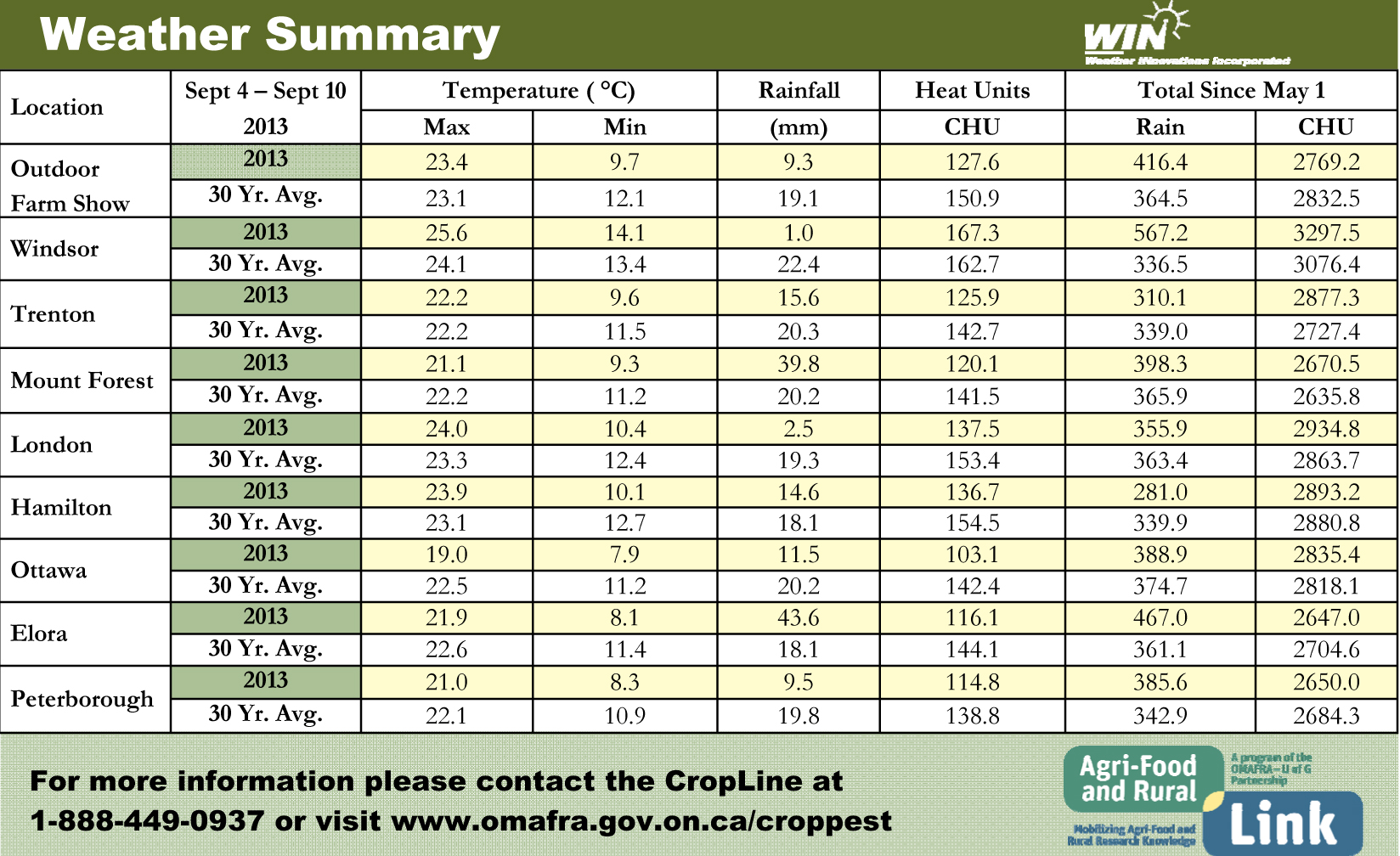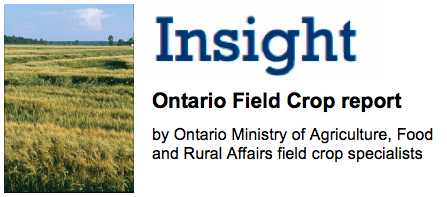Canola/Edible Beans: Brian Hall
Canola harvest ranges from 5-70% complete. Yields range from 1700 to 3400 lbs./ac with most fields yielding 2000 lbs./ac or better. Quality has been good. Do not delay swathing or harvesting as canola is subject to high shattering losses from wind, heavy rain, or hail. Uneven maturity is the biggest challenge. Optimum stage for swathing is 60% seed colour change. There is 8-10% yield advantage to swathing at 50-60% seed colour change compared to 30-40% seed colour change. If frost is forecast and the crop is not ready for harvest, swathing early to reduce green seed must occur about 3 days prior to the frost. Green seed caused by frost damage will not degreen in the swath. Edible bean harvest has been delayed in many areas due to wet weather and slow maturity of the crop. Yields to date have ranged from 17-28 cwt./ac. Staging of fields requiring a pre-harvest herbicide application should be based on the green immature areas of the field to avoid quality issues.
Cereals: Peter Johnson Spring cereal harvest drags on, with frequent showers frustrating growers. Yields and quality continue to range widely, from best ever to well below average. Producers growing winter barley to replace spring barley should plant immediately. Winter hardiness of winter barley is less than winter wheat and needs to be planted earlier to offset this weakness. Winter wheat planting is underway in the shorter season areas and will start in earnest next week. If planting on corn silage ground, a moderately resistant (MR) variety is required to be eligible for Production Insurance. Do not forget fall weed control around wheat planting: fall weed control offers many options that spring weed control cannot, with much better control of perennials and winter annuals. Where control of glyphosate resistant Canada Fleabane is needed, Eragon tankmixed with glyphosate is the best option. Cover crops oats have much less growth than last year, due to a lack of moisture. Growth of oats for a forage crop following wheat is particularly disappointing, with oats heading and barely knee high. Red clover stands and growth have been excellent in most regions, adding some excitement back into seeding clover under wheat.
Corn: Greg Stewart Corn crop development in the extreme southwest arrived at the half milk line stage in some fields this week and is on track for black layer about September 20. In other areas of the province the crop just made dent stage this week and may make black layer by months end. A killing frost (stems and leaves) that occurs at the one-half milk line will reduce yields by about 10%, alternatively a killing frost at the early dent stage will reduce yields by approximately 25%. Very dry soil conditions in some areas (near zero rain in August) has caused some kernels to not fill at the end of ears. Silage harvest is just beginning in some areas. Be sure to monitor whole plant moistures. Milk line targets (i.e. one-half to two-thirds) are reasonable tools to estimate silage moisture; however data over many years show a range in whole plant moisture at one-half milk line of 52%-72%, with an average of 63%. The recommendation is to determine whole plant moisture shortly after denting when the milk line is about 20%. Experience shows that in a typical year, corn silage at this stage dries approximately 0.5% per day. Therefore, if the sample was 70% moisture and 65% moisture is the target, harvest should be done about 10 days after the corn was sampled. Be aware that in some years and particularly on dry soils silage may dry faster that 0.5% per day.
Forages/Pastures: Joel Bagg/Jack Kyle
Forages: Double cropping fall rye or winter triticale can provide an excellent, cheap source of additional forage to fill the gap when forage supplies are short. Farmers can plant fall rye following early-fall harvested crops, particularly corn silage. Forage rye harvested as haylage in mid-May can be followed by a later planted crop, such as soybeans, edible beans, or a warm-season annual forage such as sorghum (http://fieldcropnews.com/?p=5241).
Pastures: Pasture growth has been very good in most areas of the province. The best fall growth is found in pastures managed with a multi paddock rotational system and given ample time to “rest and recover” from grazing. Leaving half of the growth in the pasture during fall grazing will allow the plants to maintain and develop root reserves to improve winter survival and set the stage for good growth next spring. Consider the use of fall cereal rye to be used for early spring grazing in 2014. Cereal rye is one of the first forage plants to grow in the spring. Having extra early spring growth to graze will give your permanent pastures the opportunity for early growth before being grazed.
Soybeans: Horst Bohner
Field maturity ranges from the R7 (beginning maturity) to the R8 (full maturity) growth stage. Many areas ran short of moisture during the critical seed fill stage in August. Top pods did not fill out as much as they could have with more soil moisture and as a result seed size could be small. Longer day soybean varieties were able to take advantage of late summer rains. Pre-harvest herbicide may still be warranted as a harvest aid in weedy fields. This will not speed up crop maturity, but will help dry down the crop and weeds more evenly, allowing timely harvest and reduced field losses. Perennial weeds such as milkweed, Canada thistle and perennial sow thistle can be controlled by a pre harvest glyphosate application when weeds are actively growing and in the bud to flowering stage. Glyphosate will not be effective on some perennial or annual weeds (e.g. ragweed) that have already set seed, nor will the seed bank of these weeds be reduced. Glyphosate should be applied at least 7 days prior to harvest, when the soybean grain moisture is less than 30% and leaf drop is at 80-90%. Check IP contracts before applying pre harvest herbicides.




